Low pay, tough working conditions and a lack of foreign labour are driving a crisis – so what can the sector do to appeal to British workers?
It’s easy to see why someone might not want to work in a warehouse. Hard physical labour. Long hours. In many cases low pay. As Wincanton’s chief people office Sally Austin delicately puts it: “There’s a huge pride in our teams about what they do – but it’s not for everybody.” The worrying thing is that these days, it often seems like it’s for nobody.
Across the whole economy, it’s never been harder to recruit workers. The latest ONS figures this week show the unemployment rate fell to its lowest level since 1974 in the three months to July. And the ratio of unemployed people to vacancies is currently around one: meaning there is exactly one unemployed person for every job.
But warehousing is having an even tougher time of it. “The driver shortage got a lot of the press in recent times but the warehouse labour shortage has been just as difficult and more prolonged,” says Alex Knowles, MD at Knowles Transport, a warehousing and distribution provider for food and drink manufacturers. “It was very challenging last year and this year is just as challenging if not worse.”
As Austin suggests, the nature of the work is no doubt a factor. While the working conditions of HGV drivers got a lot of attention as a reason for many people leaving the industry, the conditions in warehouses are arguably tougher. “[Working in a warehouse] is an even less attractive career than drivers because you’re paid a pittance,” says Jonathan Kittow, director of consultancy Simply supply chain. “At least if you’re a driver you can get somewhere between £35k and £50k a year. If you’re in a warehouse then you’re scraping £20k to £25k. And that’s assuming you’re getting overtime or a night-time bonus.” The result, says Kittow, is a “hidden labour crunch” in which warehouses up and down the country are scrabbling to find enough staff to deal with the upcoming Christmas rush.
“People will move for 20p to 30p an hour. The cost of living crisis is a factor – if I can make 20p more an hour elsewhere, I’m going to do it”
Supermarkets and logistics companies are responding by boosting wages, in most cases following a nudge from the unions. In April, workers at Sainsbury’s DHL-run distribution centre secured a pay rise of between 10% and 15%, following Unite union threats of strikes, while Unite was also behind a pay boost for Morrisons DC workers in November.
In May, Asda boosted hourly pay by 94p following negotiations with the GMB union (after first offering a deal in which pay increases would be funded from reduced sickness entitlements) and in August – amid Usdaw union pressure – 2,400 Tesco distribution centre employees secured a 9.5% pay rise, a boost that “will not only help us keep our talent, but also attract more in the local area,” according to Kev Rooney, DC manager at Tesco Lichfield at the time.
The intense competition has pushed Aldi to give two wage hikes in the space of a few months this year, with the majority of its warehouse workers now earning a minimum of £12.66 an hour, up from £11.48 at the start of the year.
The rises are piling pressure on to the likes of Amazon, which is now facing strike action at multiple DCs due to issues with pay. It began after staff were offered a 35p per hour pay rise to a minimum of £10.50 an hour, way short of the £15 demanded by GMB.

But rather than wait around in the hope of more money, the abundance of jobs is leading many people to jump ship when the opportunity arises. “People will move for 20p to 30p an hour,” says Austin at Wincanton. “The cost of living crisis is a factor – if I can make 20p more an hour elsewhere, I’m going to do it.”
The sector may therefore need to think beyond wages alone, which are already up by around 20% to 30% in recent years, says Claire Bottle, CEO of the UK Warehousing Association (UKWA). “The pay rises cannot be sustained… margins are low and labour is a high proportion of overall costs,” she explains. “If the warehousing companies can successfully pass these cost on to their customers – manufacturers and retailers – then they may prove to be sustainable, but that is by no means certain.”
According to Ross Mudie, research analyst at the Centre for Progressive Policy think tank, companies must start looking to reduce the volatility of workers’ incomes by offering more secure contracts, a move that in practice would mean moving away from an agency model of employment. “Offering more flexible working patterns to support different lifestyles and needs, such as childcare or pursuing further education, would also make the jobs more appealing, as would paying better wages.”
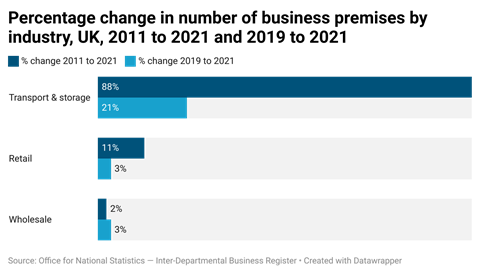
The sector must also ditch “unreasonably high and demanding output targets… and offer clear opportunities for progression for those who want it,” he adds.
Some quarters are already pursuing such change. At Wincanton, a trial is underway across four sites within a seven-mile radius in Doncaster, allowing employees to do any shift they like at any hours they like, says Austin. “It’s slightly higher pay because it’s up to you what hours you want to work.”
While it’s still early days, the impact has been “significant” Austin says, with staff attrition down to 5% from an industry average of 28%. It has also seen huge take-up among women, who are underrepresented in the industry. Such a model may be better suited for larger companies with more flexible workforces, though moves are also underway at smaller operations like Knowles Transport, which is looking to boost its appeal with a wider range of shift patterns, new workplace canteens and communal areas.
“Even if you find people, they’re probably less skilled and therefore your productivity is lower”
It is all part of an effort to shake off the lowly image of warehouse work that has permeated the public consciousness over the years. In May, BBC Three movie ‘Life and Death in the Warehouse’ offered a damning portrayal of the lives of workers at a distribution centre of an unnamed online retailer. It is essentially a horror flick, but many of the storylines have basis in real life. The sector is awash with tales of terrible conditions, unmeetable targets and exploitative agencies.
“The industry is largely built around insecure, zero-hour contracts which enable employers to very quickly lose workers in response to any sudden change in demand or output,” says Mudie. “The issue is that so much of warehouse recruitment is outsourced through external recruitment agencies, which allows the sector as a whole to get away with poor practice as it becomes more difficult to hold employers to account. And often, training opportunities and opportunities to progress are heavily limited.”
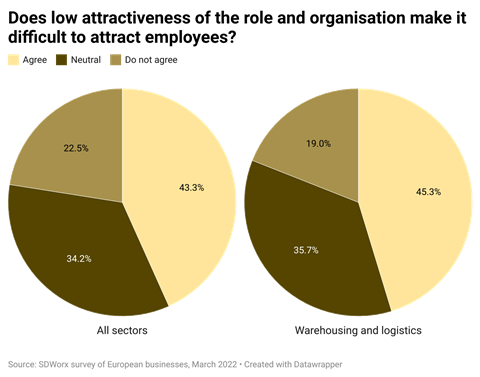
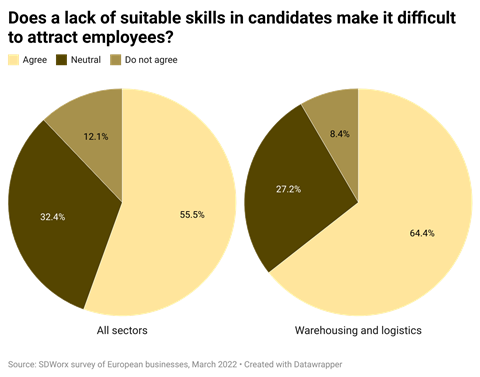

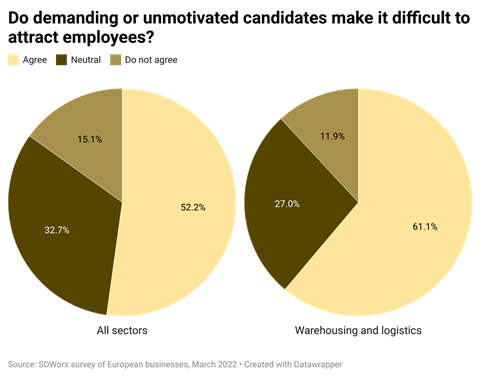
Last month, several industry groups including the UKWA, Cold Chain Federation and Logistics UK plus the likes of Asda, Tesco, Amazon, Arla, Wincanton and GXO joined forces to launch a campaign – Generation Logistics – aimed at “finding the next generation of logistics talent” to “shift perceptions of the industry”.
Starting with a focus on young adults, the campaign will then target other potential employee groups, including career switchers and maternity or paternity leave returners. Indeed, some 90% of the population has never considered working in the industry, research by Logistics UK found. Awareness is key, but so is appeal.
It could be a savvy move, with warehousing battling many of the same dynamics across the jobs market. Covid saw many warehouse workers “reassess what they want to do” says Austin, asking themselves “do I want to see family more? Traditionally the ways of working have been quite rigid, with long hours, and there’s been a stigma around those sorts of roles.”
Furthermore, the existing workforce is aging fast with Covid prompting them to “take a step back or do something different” she adds.
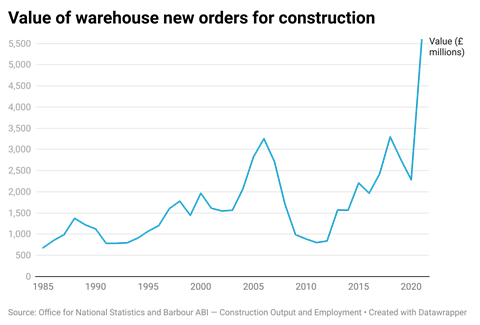
Foreign labour
The plans of ‘Generation Logistics’ will also have to contend with the impact of Brexit. In 2018, a quarter of workers in UK warehouses were EU nationals, according to data from the Confederation of British Industry, a population that has fallen dramatically in the past four years.
“Prior to Brexit it was possible to fill these jobs with such non-UK nationals, often entering jobs in warehouses via agencies and constituting a precarious migrant workforce that is temporary, easily dispensable, and low cost,” says an IFF Research report into the sector. The result was a “dependency” on foreign labour that has now largely dissipated.
“Flexible work patterns would make the jobs more appealing, as would paying better wages”
The timing is especially poor in light of the growth spurt the sector is currently undergoing. Even as consumer spending cools and the Covid-sparked online boom eases, take-up of warehouse space was up 10% year on year in the first half of 2022 at 22.6 million sq ft, according to CBRE.
As a result, vacancy rates are at a new record low of 1.2%, and the value of new warehouse developments is soaring – reaching a record high of £5.6bn in 2021, compared with £2.3bn the year prior.
More warehousing space means more staff, an equation the sector is currently unable to correct. To add further pain, the suppressed volumes could actually mean a greater need for workers, explains Kittow, as it means fewer bulk pallets, less efficiency, and less productivity. As a result, the labour crunch is likely to get worse before it gets better. After all, Kittow adds, “even if you can find people, they’re probably less skilled and therefore your productivity is lower. So there’s a whole knock-on effect there.”
It is a worrying situation, with Christmas planning now ramping up. But as last year’s HGV driver shortage proved, there are solutions at hand. They just might come with considerable pain along the way.




















No comments yet